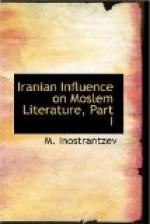[Footnote 1: Salemann, Mittel-persische Studein, Melanges Asiatiques, ix, 1888, 218.]
6. Under the sixth heading appears a Book of Counsels of Ardeshir Babekan to his son Sabur. This work which was sufficiently known and made use of in the early Moslem period has not come down to us in the original Pahlavi. We know of the existence of a verse translation of this book in the Arabic made by Belazuri (Fihrist, 113 and 114). Moreover, this work was considered as a model composition (probably as represented by Belazuri), and in this connection it was comparable (Fihrist 126, 15-19) to Kalileh wa Dimneh, the Essays of Umar Ibn Hamza,[1] Al Mahanith,[2] the tract called Yatima of Ibn al Mukaffa, and the Essays of Ahmed Ibn Yusuf, secretary of Mamun. In view of the importance attached to this and the following risalas by the author of the Fihrist, it would be interesting to have their editions and translations.
[Footnote 1: A relative of the Khalif Mansur and Mahdi, a secretary of the former Fihrist, 118, 8-12. In the Kitab al Mansur wal Manzum of Ahmed ibn Abi Taher (vide Baron B.P. Rosen, On the Anthology of Ahmed ibn Abi Taher, Journal of the Russian Oriental Society, Vol. III, 1889, page 264). The essay probably referred to is called Rasalat fi al Khamis lil Mamun. (Or Rislat al Jaysh). See Fihrist, II, 52.]
[Footnote 2: This was probably the title of the epistle of Umar Ibn Hamza to Ali ibn Mahan preserved by the same Ahmed ibn Abi Taher. As regards persons by the name of Mahan in the Musalman period see Justi Namenbuch 185.]
Extracts from this testament especially from its concluding portion, have been handed down to us in the Kitabat Tambih.[1] They relate to the prophecy of Zaradusht regarding the destruction of the Persian religion and empire in the course of a thousand years after him.[2]
[Footnote 1: By the same Ahmed ibn Abi Taher has been preserved the Essay of this Ahmed ibn Yusuf on “Thankfulness”—Risalat Ahmed ibn Yusuf fishshukr which possibly is referred to by the author of the Fihrist. See also there the highly important Risalat ibn Mukaffa fissahobat.
B.G.A. VIII, 98, 16-99, 1. Macoudi, Le livre de l’avertissement et de la revision, trad. par Carra de Vaux, Paris, 1897, 141-142.]
[Footnote 2: In connection with this prophecy, as regards the changes which were made in the chronological system of the Persian history see A. Gutschmid, Kleine Schriften, III, Leipzig, 1892. 22-23, and 97, &c.]
It is highly interesting that just like the well-known testament by Tansar to the king of Tabaristan this testament was written at a considerably later period, in the time of Anushirwan.[3]
[Footnote 3: See on this question Christensen 111-112 and Appendix VI.]
Regarding the general character of this apocryphal testament we may judge by the counsels of the founder of the Sasanian dynasty which have come down to us in various Arabic and Persian historical works and in the Shah Nameh.




